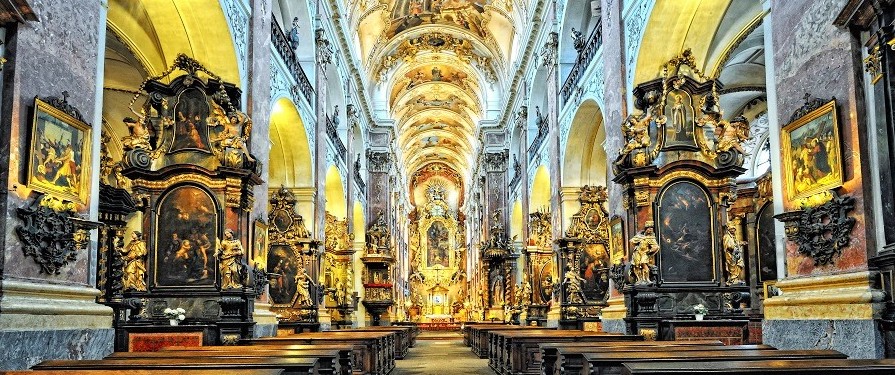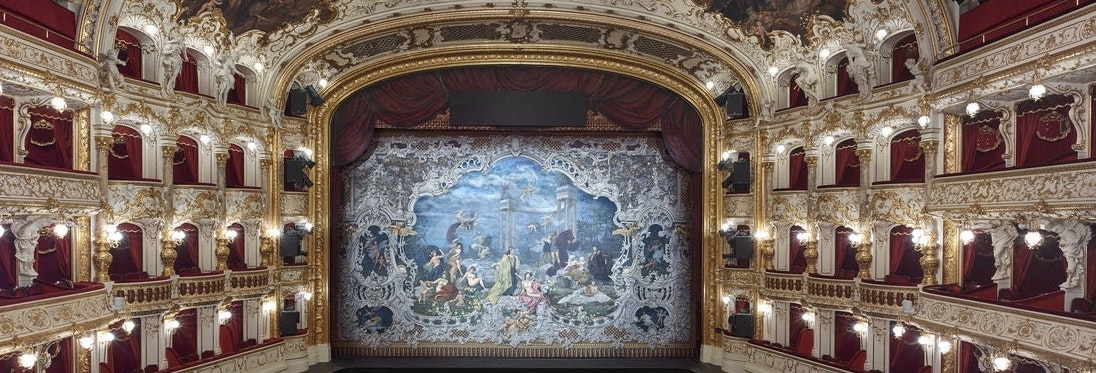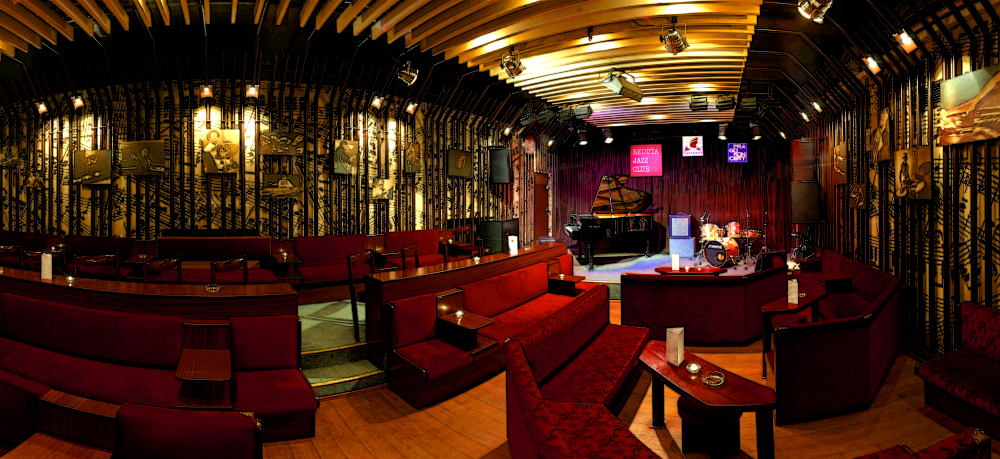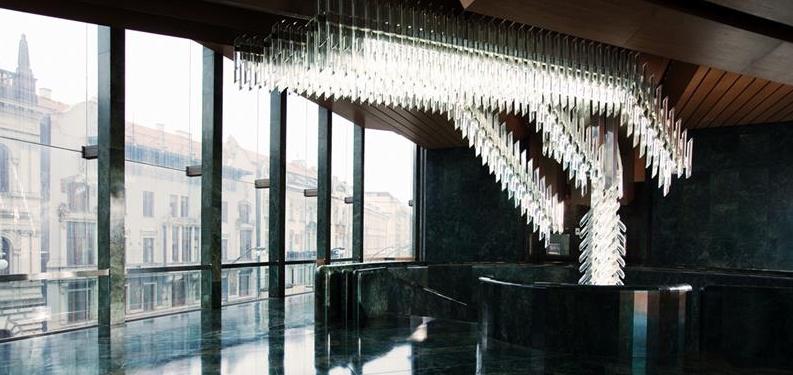Prague´s most attractive concert venues
Wonder about the most beautiful concert venues in Prague? Think no longer! We have prepared a list of the venues we find the most appealing with great history or lovely atmosphere that will make your stay in Prague simply perfect.
Klementinum Mirror Chapel
Municipal House - Smetana Hall
Rudolfinum - Dvořák Hall
Spanish Synagogue
St. Nicholas Church - Lesser Town
St. James Basilica
Prague State Opera
Estates Theatre
Jazz Dock
Reduta Jazz Club
Laterna magika - The New Stage
__________________________________________________________________________________________________________
Klementinum Mirror Chapel
 The Klementinum Mirror Chapel, originally dedicated to the Annunciation of the Virgin Mary, is a unique sanctuary and one of the churches of the former Jesuit college, Prague Klementinum. Construction of the Chapel dates to 1722-1726. The current name "Mirror" was created later, the reason was the use of many mirrors in the decoration of the walls and vaults.
The Klementinum Mirror Chapel, originally dedicated to the Annunciation of the Virgin Mary, is a unique sanctuary and one of the churches of the former Jesuit college, Prague Klementinum. Construction of the Chapel dates to 1722-1726. The current name "Mirror" was created later, the reason was the use of many mirrors in the decoration of the walls and vaults.
Interesting facts about Klementinum Mirror Chapel:
- Klementinum Mirror Chapel is part of Klementinum, one of the largest complexes in Europe inclusive of the Baroque library, Meridian hall, Astronomical tower and Mirror Chapel.
- Klementinum is also the main seat of the National Library founded in 1781.
- The original organ, still placed on the music bar (choir), was built around 1732.
- The second organ, imported here in the second half of the 20th century was additionally installed in the opposite part of the chapel, on the site of the former main altar.
- The chapel had been repeatedly desecrated and consecrated. It became a Prague classical concert and exhibition hall in 1936.
-
The Mirror Chapel also captivated W.A. Mozart himself, who apparently couldn't resist performing on the beautiful sounding organ.
Klementinum Mirror Chapel program and tickets
Municipal House - Smetana Hall
(1).jpg) Smetana Hall is overall a concert hall with a capacity of 1,200 seats, which has hosted some of the most oustanding international music ensembles and performers since its opening. In addition to concerts, it also entertains various events, such as traditional balls or galas.
Smetana Hall is overall a concert hall with a capacity of 1,200 seats, which has hosted some of the most oustanding international music ensembles and performers since its opening. In addition to concerts, it also entertains various events, such as traditional balls or galas.
The name of the concert hall is tribute to the famous Czech composer - Bedřich Smetana.
Interesting facts about Municipal House:
- The Powder Gate next to the building was an important trade route and the site of where the Municipal House now stands was used as a King's Wenceslas IV. residency in the 14th century. It was named the King's Court.
- The building was left unoccupied for a long period of time.
- The current Art Nouveau building was built from 1905 to 1911. The café, the French and the Pilsner restaurants, the American bar, the Lord Mayor’s Salon and the Smetana Hall are all examples of Art Nouveau interiors, decorated by phenomenal artists and sculptors such as Alfons Mucha, Jan Preisler, Ladislav Šaloun, and others.
Interesting facts about Smetana Hall:
- The hall serves as a venue for the Prague Spring International Music Festival’s opening and closing concerts.
- The Smetana Hall is a home stage of the Prague Symphony Orchestra.
- Ladislav Šaloun’s stucco statues called Vyšehrad and Slavonic Dances, placed along the sides of the stage, particularly stand out.
- Smetana’s Vyšehrad from the cycle of symphonic poems My Country is represented by the mythical figure of Lumír, narrating the legend of the homeland to harp accompaniment, while the dancing couple located on the opposite side is a motif from Dvořák’s Slavonic Dances.
- Smetana Hall’s interior features also other Czech composers whose portrait medallions decorate the box parapets and the parapet of the main balcony.
- Ceiling and mural paintings by Karel Špillar also contribute to joyful impression of this hall. In particular, his monumental murals Music, Poetry, Dance and Drama are some of the painter's best works.
Municipal House - Smetana Hall - program and tickets
Rudolfinum - Dvořák Hall
.jpg) The Neo-Renaissance building Rudolfinum is situated near the Old Town Square right on the bank of the river Vltava. Since its opening in 1885, it has been associated with music and art. Rudolfinum is the seat of the Czech Philharmonic. The Dvořák Hall is famous for its excellent acoustics and a smaller hall - the Suk Hall is great for chamber concerts and piano recitals.
The Neo-Renaissance building Rudolfinum is situated near the Old Town Square right on the bank of the river Vltava. Since its opening in 1885, it has been associated with music and art. Rudolfinum is the seat of the Czech Philharmonic. The Dvořák Hall is famous for its excellent acoustics and a smaller hall - the Suk Hall is great for chamber concerts and piano recitals.
The name of the concert hall is tribute to the famous Czech composer - Antonín Dvořák.
Interesting facts about Rudolfinum:
- The building was built by Česká spořitelna (Czech Savings Bank) as a cultural centre designed for exhibitions and concerts, thus connecting music and art. This is still valid.
- Did you know that you can find several beehives on the roof of the Rudolfinum?
- In 1896 the Czech Philharmonic performed in Rudolfinum for the first time and this special occassion was even more special since the most famous Czech composer Antonín Dvořák conducted the orchestra.
- The architectural design for Prague’s Rudolfinum was created by famous architects Josef Zítek and Josef Schulz, who had won a public tender. The building was constructed between 1876 and 1884.
- The Czech Philharmonic Orchestra, which includes the Czech Chamber Music Society, has been based in Rudolfinum since 1946.
- The first visitors came to the Rudolfinum Gallery in 1994.
- Since the 1990s, there has been the stylish Cafe Rudolfinum in operation.
Rudolfinum - Dvořák Hall - program and tickets
Spanish Synagogue
.jpg)
The Spanish Synagogue was built in 1868 for the local Reform congregation on the site of the 12th-century Altschul, which was the oldest synagogue in the Prague ghetto. The synagogue now belongs to the Prague´s Jewish Museum, it houses part of the exhibition, and popular concerts of classical and sacred music often take place here.
Interesting facts about Spanish Synagogue:
- The synagogue is called Spanish Synagogue for its impressive Moorish interior design, influenced by the famous Alhambra. The building was designed by Josef Niklas and Jan Bělský, the remarkable interior (from 1882–83) by Antonín Baum and Bedřich Münzberger.
- František Škroup, the composer of the Czech national anthem, served as organist here in 1836-45.
- The synagogue ceased to be used for divine services in 1941.
- Under Nazi and Communist regimes, the Spanish Synagogue was neglected and fell into a desolate state, and was eventually closed.
- The synagogue underwent several reconstructions since then.
- The synagogue is said to be one of the most beautiful synagogues in Europe.
Spanish Synagogue - program and tickets
St. Nicholas Church - Lesser Town
.jpg) The most famous Baroque masterpiece in Prague, The Church of St Nicholas, can be found on the Lesser Town square next to the former Jesuit college. With the neighbouring belfry, St Nicholas is the most distinctive and prominent landmark in the Lesser Town, completing the unique panorama of Prague.
The most famous Baroque masterpiece in Prague, The Church of St Nicholas, can be found on the Lesser Town square next to the former Jesuit college. With the neighbouring belfry, St Nicholas is the most distinctive and prominent landmark in the Lesser Town, completing the unique panorama of Prague.
Interesting facts about St. Nicholas Church:
- The church was built between 1704-1755 on the site of a Gothic church from the 13th century, which was also dedicated to Saint Nicholas.
- The diameter of the dome is an impressive 20 m; the height inside the church to the top of the lantern is almost 57 m, making it the tallest interior in Prague.
- Inside the St. Nicholas Church you'll find numerous artworks, from the frescos on the ceiling and dome to the sculptures that adorn the walls.
- The church was built according to plan of Kryštof Dientzenhofer and three generations of his family (father, son and son in law) worked on the church during the following century.
- The church’s decorations are purely Baroque.
- Karel Škréta's pictures are the most significant decoration.
St. Nicholas Church - program and tickets
Visit the St. Nicholas Church Bell Tower.
St. James Basilica
 Since the 13th century, the St. James Basilica belonging to the Franciscan order has been an important spiritual center of Prague. It has been also a stop on a pilgrimage to Santiago de Compostela.
Since the 13th century, the St. James Basilica belonging to the Franciscan order has been an important spiritual center of Prague. It has been also a stop on a pilgrimage to Santiago de Compostela.
Interesting facts about St. James Basilica:
- The impressive interior of the St. James Basilica is a treasury of Baroque art.
- There's a mummified forearm hanging by the ceiling outside the church. The legends say it belonged to the thief who wanted to steal the Virgin Marry statue from the main altar. When he tried to reach her, she caught him by the arm and wouldn't let go until the prosecutor cut it off.
- The organ at the church is actually the largest organ in the Czech Republic. The origin of the organ goes back to the 18th century. After a major fire in 1689, a new organ was built by Abraham Stark of Loket, who had by then already produced several organs for various localities in Bohemia. The new two-manual organ was completed in 1705. The organ´s case, which is still admired today, was also unique for its time.
- The basilica is now renowned for its maginificent organ concerts and festivals.
St. James Basilica - program and tickets
Check here more information about the organ.
Prague State Opera
 A prime opera house located in a magical neo-Renaissance building with a exquisitely decorated interior was refurbished in 2020. A famous ballets and operas, as well as pieces forgotten or unknown in the Czech Republic are introduced in the State Opera gaining the theatre a reputation of one of the best European scenes.
A prime opera house located in a magical neo-Renaissance building with a exquisitely decorated interior was refurbished in 2020. A famous ballets and operas, as well as pieces forgotten or unknown in the Czech Republic are introduced in the State Opera gaining the theatre a reputation of one of the best European scenes.
Interesting facts about State Opera:
- This Neo-classical edifice was built in 1888 by the German Theatre Association as a reaction of German minority in Prague to the opening of the Prague National Theatre.
- The theatre was originally called the New German Theatre and from 1949 to 1989 it was known as the Smetana Theatre.
- The first performance of the opera house on January 5th 1888 was the Richard Wagner's opera Die Meistersinger von Nürnberg.
- The State Opera is part of the National Theatre.
Prague State Opera - program and tickets
Estates Theatre
 The Estates Theatre is one of the most beautiful historical theatre buildings in Europe opened in 1783. The opera house is globally renowned for its special connection with the famous composer W. A. Mozart. The theatre offers opera and ballet performances as well as Czech and international drama.
The Estates Theatre is one of the most beautiful historical theatre buildings in Europe opened in 1783. The opera house is globally renowned for its special connection with the famous composer W. A. Mozart. The theatre offers opera and ballet performances as well as Czech and international drama.
Interesting facts about Estates Theatre:
- W. A. Mozart composed the Don Giovanni opera for Prague, and personally conducted its world premiere in the Estates Theatre. It is the only theatre left standing where Mozart performed.
- The Estates Theatre was one of the locations in the famous film Amadeus by Miloš Forman.
- The play Fidlovačka by J. K. Tyl and F. Škroup premiered in the Estates Opera and includes the song “Kde domov můj” (Where is My Home), which would later become the Czech national anthem.
- German was the language at the Estates Theatre until 1920, when it was taken over by Czechs and affiliated to the National Theatre.
Estates Theatre - program and tickets
Jazz Dock
.jpg)
Jazz Dock situated on the Vltava river banks opened in 2009 and has become one of the important European jazz clubs featuring jazz, blues, world music, soul etc. The interior of the jazzclub is modern and cozy - great for both chamber performances as well as big productions. It's lovely atmosphere, variable program and great location is what constantly draws us back in.
Interesting facts about Jazz Dock:
- Jazz Dock´s ten meters long futuristic bar offers traditional drinks and cocktails and also specialities.
- You can savour in Jazz Dock kitchen´s delicatessen and treat yourself to a tasty dinner, all the time during musical production.
- Jazz Dock has its own music concept. It´s dramaturgy is specific for its several-days concert blocks of significant Czech jazz bands and foreign bands and regular jazz festivals focused on a particular jazz genre, specific country or dominant jazz instrument.
Jazz Dock - program and tickets
Reduta Jazz Club
 Reduta Jazz Club was founded in 1957 and is the oldest continously operated jazz and theatre club in the world. A place where you will have a great musical experience. Reduta is a term and a part of history, a cultural monument mentioned in professional publications and shown in movies. The club is located near the National Theatre, Old Town Square and Wenceslas Square.
Reduta Jazz Club was founded in 1957 and is the oldest continously operated jazz and theatre club in the world. A place where you will have a great musical experience. Reduta is a term and a part of history, a cultural monument mentioned in professional publications and shown in movies. The club is located near the National Theatre, Old Town Square and Wenceslas Square.
Interesting facts about Reduta:
- You can enjoy a drink in the traditional Saxophone Bar, which offers a variety of drinks including beer tapped into a golden saxophone.
- When the club was opened, the artists of Czechoslovakia were oppressed by the communist regime and times were really hard. Reduta has been one of the first experimental theatres, starting a revolution in European acting methods. And after performances, dissidents and crusaders for free country has been meeting in the club, discussing and planing until dawn. The regime has taken strong actions against them, but Reduta and its faithful continued until the fall of communist dictatorship and 30 years after the Velvet Revolution the jazzclub is still going strong.
- In 1994, the U.S. president Bill Clinton met with Czech president Václav Havel, and many more significant politicians, businessmen in Reduta.
Reduta Jazz Club - program and tickets
Laterna magika - The New Stage
 Most likely the world's first multimedia theatre, Laterna magika was founded as a cultural program at the 1958 Brussels Expo. It launched its official activity in 1959, as an independent company of the National Theatre, performing at the Adria palace in Prague.
Most likely the world's first multimedia theatre, Laterna magika was founded as a cultural program at the 1958 Brussels Expo. It launched its official activity in 1959, as an independent company of the National Theatre, performing at the Adria palace in Prague.
Interesting facts about Laterna magika:
- The building of the New Stage of National Theatre was tailored to the specific requirements of Laterna magika performances. The unconventional edifice, covered by over four thousand pieces of glass tiles, was designed by Karel Prager.
- Wonderful Circus, which premiered in 1977, is the most frequently performed theatre piece in Central Europe, and has remained in the repertoire ever since.
-
The fantastic world of the Laterna magika is full of pantomime, dance, music, film and black light theatre.




